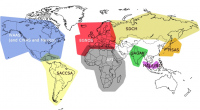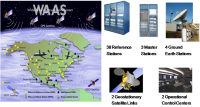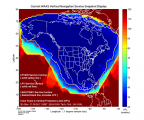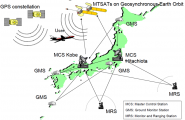If you wish to contribute or participate in the discussions about articles you are invited to contact the Editor
SBAS Systems
| Fundamentals | |
|---|---|
| Title | SBAS Systems |
| Edited by | GMV |
| Level | Basic |
| Year of Publication | 2011 |
SBAS systems are spreading out all over the world. More and more, it is believed that upon dual-frequency SBAS service provision, a seamless navigation will be possible from and to any two locations in the world.
SBAS in the World
From all the SBAS systems in the world, three are already operational (WAAS, MSAS, EGNOS), three are under implementation (GAGAN, SDCM, SNAS) while others are under feasibility studies, for instance SACCSA.
WAAS
The Wide Area Augmentation System (WAAS) was jointly developed by the United States Department of Transportation (DOT) and the Federal Aviation Administration (FAA), beginning in 1994, to provide performance comparable to category I instrument landing system (ILS) for all aircraft possessing the appropriately certified equipment.[1]
On July 10, 2003, the WAAS signal was activated for safety-of-life aviation, covering 95% of the United States, and portions of Alaska.[1] At present, WAAS supports en-route, terminal and approach operations down to a full LPV-200 (CAT-I like Approach Capability) for the CONUS, Mexico and Canada.
MSAS
The Multi-functional Satellite Augmentation System (MSAS) is the Japanese SBAS. NEC manufactured and delivered MSAS under contract with the Civil Aviation Bureau, Ministry of Land, Infrastructure, Transport and Tourism.
MSAS is operational since 2007 supporting en-route, terminal and non-precision approach operations (RNP 0.1). Recently has completed successful LPV flight trials.
GAGAN
The GPS Aided Geo Augmented Navigation or GPS and Geo Augmented Navigation system (GAGAN) is the SBAS implementation by the Indian government. The Indian government states that it will use the experience of building the GAGAN system in the creation of an autonomous regional navigation system called the Indian Regional Navigational Satellite System (IRNSS).[2]
The final, operational phase of GAGAN is likely to be completed in 2013.[2]
GAGAN overview.[2]
SDCM
The System for Differential Corrections and Monitoring (SDCM) is the SBAS currently being developed in the Russian Federation. SDCM is expected to be certified in the coming years, being this just the first step in the SDCM strategy which pursues also other broadcast means –potentially a polar MEO– with the aim of providing also a service to the North part of Russia.
The main differentiator of SDCM with respect to other SBAS systems is that it is conceived as an SBAS augmentation to GPS and GLONASS, whereas the rest of current SBAS initiatives provide corrections and integrity just to GPS satellites.
- Sdcm overview.png
SDCM planned station network
SNAS
The People's Republic of China is developing its own SBAS, called Satellite Navigation Augmentation System (SNAS). The company Novatel was awarded with a contract for the provision of 12 receivers for the phase 2 of the development in 2002.[3] These stations would complement the 11 ones already installed around Beijing for the phase 1. There is little public information available on this development.
SACCSA
The SBAS initiative in South/Central America and the Caribbean is called SACCSA (Soluciόn de Aumentaciόn para Caribe, Centro y Sudamérica). SACCSA is an ICAO project founded by the Participants/Member States of the SACCSA Project: Argentina, Bolivia, Colombia, Costa Rica, Guatemala, Panama, Spain, Venezuela and COCESNA (Corporación Centroamerica de Servicios de Navegación Aérea). The objective is to study the improvement of the Air Navigation Environment in the Caribbean and South America (CAR/SAM) Regions with a SBAS solution. The program began in 2003 being at present in its Phase III which will determine the feasibility of the implementation of an own SBAS system in the CAR/SAM regions.
Notes





![GAGAN overview.[2]](/navipedia/images/thumb/c/c1/Gagan_overview.png/182px-Gagan_overview.png)